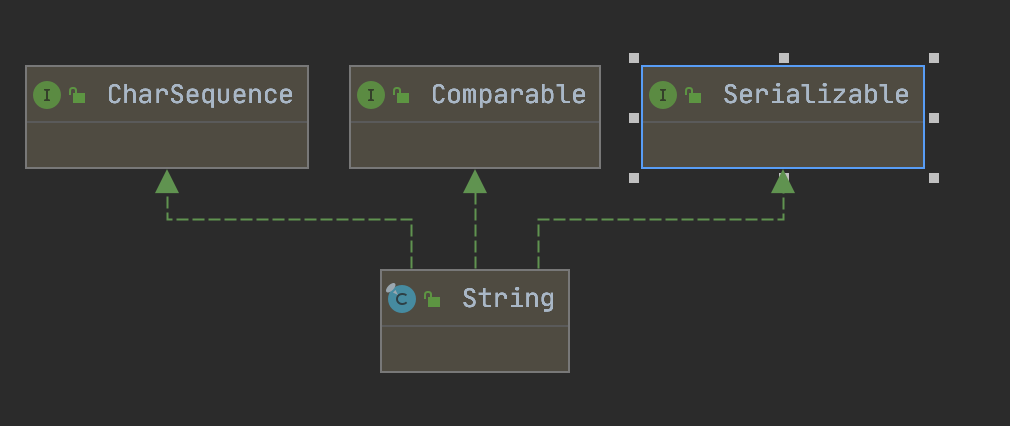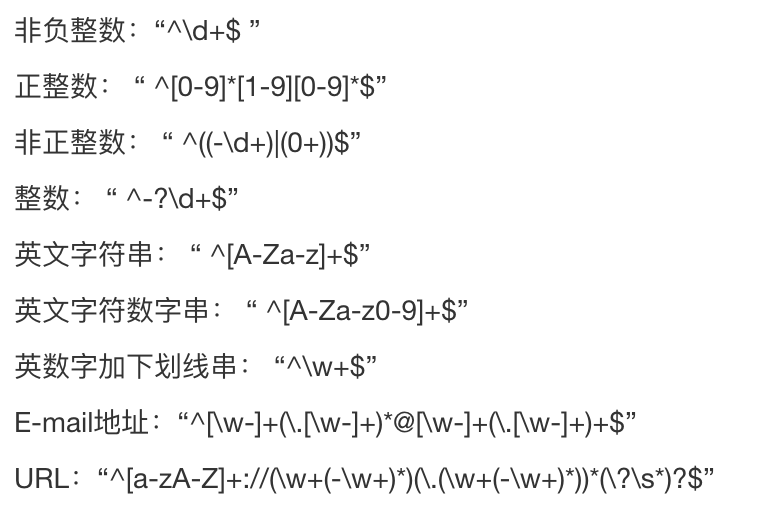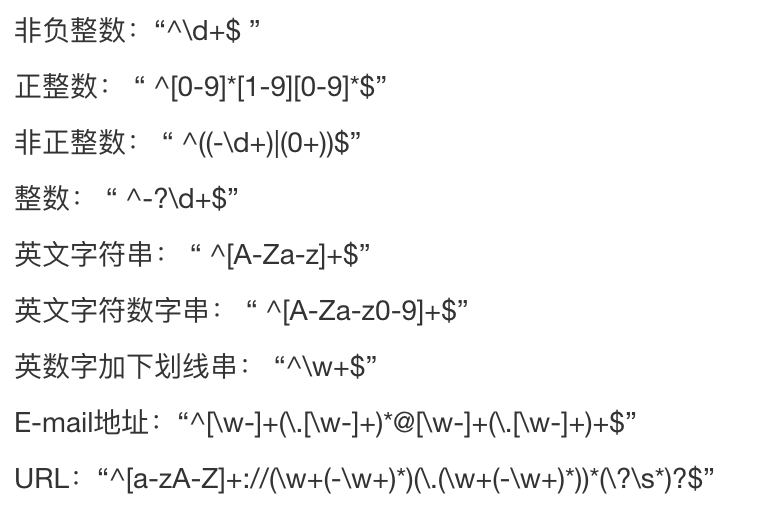在哪里??
java.util.regex包下有两个用于正则表达式的类, 一个是Matcher类, 另一个Pattern
简单例子
public class RegexLeaning { public static void main(String[] args) { Pattern p = Pattern.compile("[a-z]{3}"); Matcher m = p.matcher("bac"); System.out.println(m.matches()); } //结果:true }
Pattern可以理解为一个模式, 字符串需要与某种模式进行匹配,上面设置的就是匹配a-z中的三个字母
Matcher可以理解为模式匹配某个字符串后产生的结果
Pattern类中的compile方法, 也就是说对我们传入的正则表达式编译后得到一个模式对象. 而这个经过编译后模式对象,
会使得正则表达式使用效率会大大提高, 并且作为一个常量, 它可以安全地供多个线程并发使用
第一类正则表达式:
/** * . Any character (may or may not match line terminators), 任意字符 * X? X, once or not at all 零个或一个 * X* X, zero or more times 零个或多个 * X+ X, one or more times 一个或多个 * X{n} X, exactly n times x出现n次 * X{n,} X, at least n times x出现至少n次 * X{n,m} X, at least n but not more than m times 出现n~m次
第二类正则表达式:
/** * \d A digit: [0-9] 数字 * \D A non-digit: [^0-9] 非数字 * \s A whitespace character: [ \t\n\x0B\f\r] 空格 * \S A non-whitespace character: [^\s] 非空格 * \w A word character: [a-zA-Z_0-9] 数字字母和下划线 * \W A non-word character: [^\w] 非数字字母和下划线 */
[]用于描述一个字符的范围
Pattern类:
/** * 将给定的正则表达式编译并赋予给Pattern类 * * public static Pattern compile(String regex, int flags) * public static Pattern compile(String regex) */ Pattern p = Pattern.compile("a+",Pattern.CASE_INSENSITIVE); System.out.println(p.flags());//2 /** * String pattern() 返回该pattern对象所编译的正则表达式 */ Pattern p1 = Pattern.compile("\\d+"); System.out.println(p1.pattern());//\d+
String[] split()
/** * String[] split() 按regex分隔字符串,返回字符串数组 * * public String[] split(CharSequence input, int limit) * intput:需要财富的字符串序列 * limit是控制应用模式的次数,影响数组的长度 * n>0 :模式至少应用n-1次,数组长度不大于n。 * n != 正数:模式应用无限制,并且数组可任意长度 * n =0 :模式应用无限制,并且数组可任意长度,丢弃尾部空字符串 * * * public String[] split(CharSequence input) */
Pattern p2 = Pattern.compile("\\d+");
String[] str = p2.split("全12电话89和收集");
String[] str2 = p2.split("全12电话89和收集",2);
System.out.println(Arrays.toString(str));//[全, 电话, 和收集]
System.out.println(Arrays.toString(str2));//[全, 电话89和收集]
备注:因为String 实现了ChraSequence接口,所以直接可以用字符串

Pattern.matches
/** * 快速匹配字符串,该方法适合用于只匹配一次,且匹配全部字符串. * * public static boolean matches(String regex, CharSequence input) { * Pattern p = Pattern.compile(regex); * Matcher m = p.matcher(input); * return m.matches(); * } */
Boolean re1 = Pattern.matches("\\d+","232");//true
Boolean re2 = Pattern.matches("\\d+","23aa2");//false
Pattern类中的matcher方法
/** *返回一个Macher对象 * *因为Matcher的构造方法也是私有的 ,不能随意创建, * 只能通过下面方法创建了 * public Matcher matcher(CharSequence input) */
Pattern p3 = Pattern.compile("\\d+");
Matcher matcher = p3.matcher("2321");
System.out.println("p3"+matcher.pattern());//返回该Matcher对象是由哪个Pattern对象的创建的
Machter类
获得实例
Pattern pattern1 = Pattern.compile("\\d+");
/**
* Matcher的构造方法也是私有的,只能通过pattern类中的matcher方法创建
*/
Matcher matcher1 = pattern1.matcher("quan1zhi2qiang3hao4");
pattern()
/** * Matcher中的方法pattern()获取建立matcher实例时的pattern * 即构造器传入的Pattern对象。 */
System.out.println(matcher1.pattern());//\d+
matches()
/** * Matcher里面的matches方法, * 对整个字符串进行匹配,只有整个字符串都匹配了才返回true。 */
String mailstr = "1234@163.com"; Pattern pattern = Pattern.compile("[\\w\\.]+@[\\w\\-\\.]+[\\w\\-]+"); Matcher matcher = pattern.matcher(mailstr); System.out.println(matcher.matches());//true
lookAt()
/** * Matcher.lookingAt()对前面的字符串进行匹配,只有匹配到的字符串在最前面才返回true。 *lookingAt是部分匹配,总是从第一个字符进行匹配,匹配成功了不再继续匹配,匹配失败了,也不继续匹配。 */
String str1 = "123quan"; String str2 = "quan123"; Pattern pattern3 = Pattern.compile("\\d+"); Matcher matcher3 = pattern3.matcher(str1); Matcher matcher4 = pattern3.matcher(str2); System.out.println(matcher3.lookingAt());//true System.out.println(matcher4.lookingAt());//false if(matcher4.find()){ System.out.println(matcher4.group());//123 }
find()
/** * find()是部分匹配,从当前位置开始匹配,找到一个匹配的子串,将移动下次匹配的位置。 * * 该方法的前一次调用成功了并且从那时开始匹配器没有被重置,则从以前匹配操作没有匹配 * 的第一个字符开始。如果匹配成功,则可以通过 start、end 和 group 方法获取更多信息。 */
String str5 = "111quan222qq333"; Pattern pattern5 = Pattern.compile("\\d+"); Matcher matcher5 = pattern5.matcher(str5); while (matcher5.find()){ System.out.println(matcher5.group()); } /* 111 222 333 */
matches lookAt find联系
/** * matches lookAt find 的联系和区别; *都放回boolean类型: * 1,Matcher.matches() 对整个字符串进行匹配,只有整个字符串都匹配了才返回true * 2,Matcher.lookingAt() 从输入的头开始找,只有字符串的前缀满足模式才返回true * 3,Matcher.find() 对字符串进行匹配,匹配到的字符串可以在任何位置. */
String str6 = "111quan222qq333"; Pattern pattern6 = Pattern.compile("\\d+"); Matcher matcher6 = pattern6.matcher(str6); matcher6.matches();//匹配在q这里失败了,下次匹配位置从位置4开始 //下次匹配 matcher6.find(); System.out.println(matcher6.start());//查看这次匹配成功的开始位置 //7 matcher6.reset();//回到初始位置 matcher6.lookingAt(); System.out.println(matcher6.start());//查看这次匹配成功的开始位置 //0
替换的三个方法:
/** *replaceAll 替换符合所有Regex的部分 * replaceFirst 替换第一个符合regex的部分 * replace 用字符串替换字符串,没有匹配规则 */
String str7 = "111quan222qq333"; Pattern pattern7 = Pattern.compile("\\d+"); Matcher matcher7 = pattern6.matcher(str7); System.out.println(matcher7.replaceAll("@"));//@quan@qq@ System.out.println(matcher7.replaceFirst("*"));//*quan222qq333 //字符串里面也有替换函数 System.out.println(str7.replace("111","BBB"));//BBBquan222qq333 System.out.println(str7.replaceAll("\\d+","ALL"));//ALLquanALLqqALL System.out.println(str7.replaceFirst("\\d+","FIRST"));//FIRSTquan222qq333
正则表达式详解:
常用书写符号:

常用限定字符:

预定义字符集:

常用regex:

public class DemoRegex { public static void main(String[] args) { String qqstr = "12898878332"; String qqreg = "[1-9]\\d{4,13}";//QQ没有0开头的 Pattern pattern1 = Pattern.compile(qqreg); Matcher matcher = pattern1.matcher(qqstr); boolean re = matcher.matches(); System.out.println(re);//true //按照叠词切割:其中\\1表示前面括号里面的组 String[] strings = qqstr.split("(.)\\1+"); System.out.println(Arrays.toString(strings));//[1289, 78, 2] } }
http://www.51gjie.com/java/766.html
组:
A(B(C))D 有三个组:组 0 是 ABCD,组 1 是 BC,组 2 是 C,
可以根据有多少个左括号来来确定有多少个分组,括号里的表达式都称子表达式。
"(.)\\1+"
\\1就是反向引用